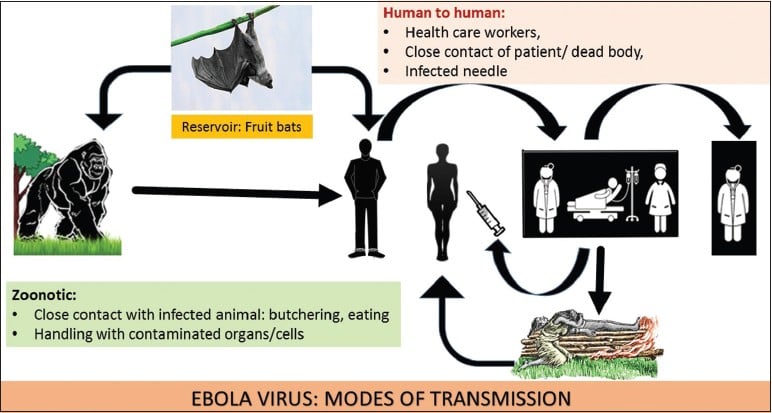
In some cases, this mode of transmission has been interpreted to mean that infection occurs only outside the space occupied by the infectious person. An infectious patient may emit droplets during coughing, sneezing, and talking and through medical procedures like suctioning, endotracheal intubation, cough induction by chest physical therapy, and cardiopulmonary resuscitation.Īirborne transmission is defined by HICPAC as resulting from the inhalation of small respirable particles that "remain infective over time and distance" and "can be dispersed over long distances by air currents." This description seems to imply that transmission will occur only if the person being infected is not face-to-face with an infectious individual.
#EBOLA WAYS OF TRANSMISSION SKIN#
In indirect contact transmission, the body fluid containing the microorganism contaminates an object, such as a piece of medical equipment, and the microorganism transfers into the healthcare worker's body through breaks in his skin when he handles the object.ĭroplet transmission is described by HICPAC as a form of direct contact transmission in which "respiratory droplets carrying infectious pathogens transmit infection when they travel directly from the respiratory tract of the infectious individual to susceptible mucosal surfaces of the recipient, generally over short distances, necessitating facial protection." These droplets are considered "propelled" from the infectious person. Indirect contact transmission, which "involves the transfer of an infectious agent through a contaminated intermediate object or person."Īn example of direct contact transmission is the direct entry of blood or body fluids containing microorganisms into a healthcare worker's body through breaks in her skin, such as when she touches a patient's wound.Direct contact transmission, which "occurs when microorganisms are transferred from one infected person to another person without a contaminated intermediate object or person," or.

Each mode of transmission is associated with a suite of infection control practices.Ĭontact transmission is described by the Healthcare Infection Control Practices Advisory Committee (HICPAC) as 3: The traditional disease transmission paradigm for healthcare settingsĪs we understand the traditional disease transmission paradigm for healthcare settings, three primary modes of transmission exist: contact, droplet, and airborne. We also discuss evidence that supports Ebola transmission by all of these modes in patient care settings-and highlight why the CDC guidance might oversimplify transmission and underestimate risks.

2 We describe here a new paradigm of disease transmission that includes direct contact, indirect contact, and aerosol transmission. An Institute of Medicine report released last week underscores the importance of conducting studies to better understand all modes of EVD transmission, including by aerosols. In a previous commentary, we discussed why direct contact may not be the only mode of EVD transmission, particularly in healthcare settings. 1 The CDC guidance states, "In healthcare settings, Ebola is spread through direct contact (e.g., through broken skin or through mucous membranes of the eyes, nose, or mouth) with blood or body fluids of a person who is sick with Ebola or with objects (e.g., needles, syringes) that have been contaminated with the virus." On Oct 20, the US Centers for Disease Control and Prevention (CDC) released updated guidelines for the protection of healthcare workers caring for patients with Ebola virus disease (EVD). The authors do not endorse any specific manufacturer or brand of personal protective equipment (PPE) and have no direct or indirect financial interest in the use of a specific brand of PPE.

The authors have not received any compensation for the preparation of this commentary or any associated public statements. It does not represent the opinion of the University of Illinois at Chicago or any other organization. Submitted commentaries do not necessarily represent the scientific position of CIDRAP.Īuthors' disclaimer: This commentary reflects the personal opinions of the authors. Dr Jones is an Assistant Professor and Dr Brosseau is a Professor in the School of Public Health, Division of Environmental and Occupational Health Sciences, at the University of Illinois at Chicago. In September they published a commentary on optimal respiratory protection for Ebola, and in May they published a similar commentary on MERS-CoV. Editor's note: Today's commentary was submitted to CIDRAP by the authors, who are national experts on respiratory protection and infectious disease transmission.


 0 kommentar(er)
0 kommentar(er)
